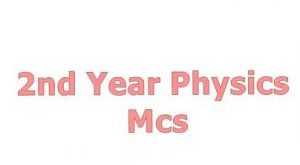On this page, you can get the 1st Year Physics Chapter 1 Measurement MCQs with Answers. In this chapter, the importance of physics and measurement of the quantities are illustrated. Physics is actually the study of the Entire Physical World. To describe the physical world, there are Base Quantities and Derived Quantities. The whole world has adopted the International System of Units. While measuring, some errors occur i.e. Random and Systematic Errors. Two different terms, Precision, and Accuracy are defined in this Chapter. Significant figures, Scientific notation, and Dimensions of Physical Quantities are also discussed in the Chapter. So, this is the best source to get important MCQs online.
1st Year Physics Chapter 1 Measurement MCQs with Answers

KEY POINTS
- Physics
- Physical Quantities
- International System of Units
- Errors and Uncertainties
- Significant Figures
- Precision and Accuracy
- Dimensions of Physical Quantities
Question#1. Which one is not a branch of physical sciences?
- Chemistry
- Astronomy
- Geology
- Biology
Answer
Answer
Question#2. The dimension of energy density is the same as that of?
- Pressure
- Force
- (Velocity)2
- Acceleration
Answer
Answer
Question#3. Which property of a solid object cannot be changed by the application of force?
- Length
- Mass
- Area
- Speed
Answer
Answer
Question#4. For what physical quantity is the pascal a unit?
- Stress
- Pressure
- Young’s modulus
- All of these
Answer
Answer
Question#5. In scientific notation, numbers are expressed in?
- Power of ten
- Powers of two
- Reciprocal
- Decimal
Answer
Answer
Question#6. 1024 can be written in scientific notation as?
- 1.024 x 103
- 210
- 0.000976
- 1/0.00097
Answer
Answer
Question#7. Prefix deca represents?
- 101
- 102
- 103
- 10-1
Answer
Answer
Question#8. The error in measurement may occur due to?
- Inexperience of a person
- The faulty apparatus
- Inappropriate method
- Due to all reasons in a, b and c
Answer
Answer
Question#9. The uncertainty in measurement may occur due to?
- Limitation of an instrument
- Natural variation of the object to be measured
- Inadequate of technique
- All given in a, b and c
Answer
Answer
Question#10. Random error can be reduced by?
- Taking zero correction
- Comparing the instrument with another more accurate one
- Taking mean of several measurements
- All methods explain in a, b and c
Answer
Answer
Question#11. In any measurement the significant figures are?
- All accurately known and all doubtful digits
- Only accurately known digits
- Only doubtful digits
- All accurately known digits and the first doubtful
Answer
Answer
Question#12. A digit zero in a measurement?
- May be significant may not significant
- Always significant
- Always insignificant
- Significant only if left to a significant figure
Answer
Answer
Question#13. The number of significant figures in 0.0173 are?
- Three
- Four
- Five
- Two
Answer
Answer
Question#14. Smaller the least count of the instrument more is the measurement?
- Accurate
- Precise
- Accurate and Precise
- None of these
Answer
Answer
Question#15. Which system of the units is a coherent system of units in mechanics?
- CGS
- MKS
- FPS
- All of these
Answer
Answer
Question#16. ML-1T-2 is the dimension of?
- Force
- Pressure
- Momentum
- Energy
Answer
Answer
Question#17. Dimensional analysis is helpful for?
- Deriving a possible formula
- Checking the homogeneity of a physical equation
- Verification of laws
- Only a and b are correct
Answer
Answer
Question#18. Which equation is not dimensionally correct?
- E=mc2
- Vf=Vi+at
- S=Vt2
- S=1/2 at2
Answer
Answer
Question#19. SI unit of coefficient of viscosity is?
- kg.m.s-1
- kg.m-1.s-1
- kg.m.s
- kg-1m-1s-1
Answer
Answer
Question#20. Three students measured length of needle with meter rod and recorded as: (i) 0.2145m (ii) 0.21m (iii) 0.214m. Which one is a correct record?
- Only (i)
- Only (ii)
- Only (iii)
- Both (i) and (ii)
Answer
Answer
Question#21. One light-year is equal to?
- 9.5×1015m
- 9.5×1015sec
- 9.5×1015km
- 9.5×1015cm
Answer
Answer
Question#22. Absolute uncertainty in a measurement depends upon?
- The magnitude of the measurement
- Least count of the instrument
- The percentage error in the measurement
- System of unit
Answer
Answer
Question#23. Steradian is the SI unit of?
- Plane angle
- Solid angle
- Both plane angle and solid angle
- Neither plane angle nor solid angle
Answer
Answer
Question#24. Which pair has the same dimension?
- work, torque
- Work, energy
- Energy, torque
- All are correct
Answer
Answer
Question#25. Total uncertainty, in the result obtained from the subtraction of two measurements, is equal to?
- Sum of their absolute uncertainties
- The difference of their absolute uncertainties
- Product of their absolute uncertainties
- Division of their absolute uncertainties
Answer
Answer
Question#26. Which one is the highest power multiple?
- Giga
- Peta
- Mega
- Deca
Answer
Answer
Question#27. One femto stands for?
- 10-15
- 10-12
- 10-9
- 10-6
Answer
Answer
Question#28. Percentage uncertainty in radius r is 2%. The percentage uncertainty in the volume of a sphere is?
- 4%
- 6%
- 8%
- 9%
Answer
Answer
Question#29. The unit of force is _______ and its symbol is ________ . Which is the correct pair?
- Newton, n
- Newton, N
- newton, n
- newton, N
Answer
Answer
Question#30. Which of the following length is more precise measured by the instrument having least count of 0.00001cm? (1) 5cm (2) 5.00cm (3) 5.000cm (4) 5.00000cm.
- 1
- 2
- 3
- 4
Answer
Answer
Question#31. Which one is the derived quantity in SI units?
- Electric current
- Electric charge
- Plane angle
- Amount of substance
Answer
Answer
Question#32. Which one is the correct representation of the unit of pressure?
- Newton / Meter2
- newton / meter2
- Newton / meter2
- newton / Meter2
Answer
Answer
Question#33. Which one is the dimensionally correct equation?
- f=vt
- S=Vit + ½ at2
- V=St
- V=f/t
Answer
Answer
Question#34. Zero error of the instrument is a type of?
- Random error
- Personal error
- Systematic error
- Classified error
Answer
Answer
Question#35. In multiplication and division of measurement?
- Percentage uncertainties are added?
- Absolute uncertainties are added
- Percentage uncertainties are divided
- Absolute uncertainties are divided
Answer
Answer
Question#36. The number of significant figures in 5.400 are?
- Three
- Five
- Two
- None
Answer
Answer
Question#37. To reduce the uncertainty in the timing experiment?
- Use the highly precise instrument
- Conduct at room temperature
- Count number of vibration
- Both a and c
Answer
Answer
Question#38. The number of significant figures in the length of a bar 9800mm measured by meter rod is?
- Four
- Three
- Two
- None of these
Answer
Answer
Question#39. A wire when heated shows a 2% increase in length. The increase in the cross-section area would be?
- 1%
- 2%
- 4%
- 8%
Answer
Answer
Question#40. Which of the following is not a correct representation method of prefixes?
- 1mm
- 10km
- 1000 μ
- Both a and b
 Online Exams Tests Preparation
Online Exams Tests Preparation


